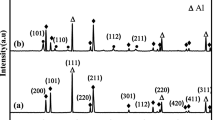Abstract
Tin whisker formation has been a serious concern for application of pure tin as a Pb-free component lead finish. It has been long believed that residual stress is the root cause of whisker formation. A fundamental question is if stress produced by other than the plating processing and post-plating metallurgical reactions can induce whisker formation. In this study, micro indents were made on pure tin plated component leads to introduce a stress field and a scanning electron microscope was used to monitor the nucleation of whiskers in-situ. Nanoindentation was also performed to measure hardness and elastic modulus of the tin coating and substrate. The stress/strain field around the micro-indent was calculated using finite element method. Experimental and theoretical calculation results show that stress gradient plays an important role in whiskers nucleation.





Similar content being viewed by others
References
G.T. Galyon, IEEE Trans. Elec. Pack. Manu. 28, 94 (2005)
J. Brusse, G. Ewell, J. Siplon, Tin whiskers: Attributes and mitigation, Capacitor and Resistor Technology Symposium (CARTS 02), held at New Orleans, LA, March 25–29, 2002
G.T. Galyon, L. Palmer, IEEE Trans. Elec. Pack. Manu. 28, 17 (2005)
R.M. Fisher, L.S. Darken, K.G. Carroll, Acta Matall. 2, 368 (1954)
V.K. Glazunova, Kristallografiya, 7, 761 (1962)
C.H. Pitt, R.G. Henning, J. Appl. Phys. 35, 459 (1964)
W.J. Choi, T.Y. Lee, K.N. Tu, N. Tamura, R.S. Celestre, A.A. McDowell, Y.Y. Bong, N. Liu, Acta Mater. 51, 6253 (2003)
G.T. Galyon, L. Palmer, The structure and kinetics of tin-whisker formation and growth on high tin content finishes, Handbook of Lead-Free solder Technology for Microelectron Assemblies, ed. K.J. Puttlitz and K.A. Stalter, (Marcel Dekker Inc. 2004) p. 851
W.C. Oliver, G.M. Pharr, J. Mater. Res. 7, 1564 (1992)
D. Tabor, The Hardness of Metals, (The Clarendon Press, Oxford, 1951)
G. Ghosh, J. Mater. Res. 19, 1439 (2004)
http://hcrosscompany.com/metals/alloy4252.htm
W.D. Zhang, P.C. Chang, R.Y. Chou, R.K. Shiue, Microelec. Reliab. 41, 2011 (2001)
K.N. Tu, J.C.M. Li, Mater. Sci. Eng. A 409, 131 (2005)
A. Gouldstone, H.J. Koh, K.Y. Zeng, A.E. Giannakopoulos, S. Suresh, Acta Mater. 48, 2277 (2000)
Z.-H. Xu, J. Agren, Phil. Mag. 84, 2367 (2004)
X. Deng, M. Koopman, N. Chawla, K.K. Chawla, Mater. Sci. Eng. A 364, 240 (2004)
J. Kruger, in: K.H. Buschow, et al. (eds.) Encyclopedia of Materials: Science and Technology, 10 (Elsevier, Amsterdam 2001) p. 9352
W.D. Calllister, Introduction to Materials Science and Engineering, (Wiley, New York, 2002)
B.Z. Lee, D.N. Lee, Acta Metall. 46, 3701 (1998)
Acknowledgements
Financial support for this study was provided by the National Science Foundation (Grant No. EPS-0296165), the University of South Carolina Research Foundation Equipment Grant Award, and the University of South Carolina NanoCenter. The content of this information does not necessary reflect the position or policy of the Government and no official endorsement should be inferred.
Author information
Authors and Affiliations
Corresponding author
Rights and permissions
About this article
Cite this article
Liang, J., Xu, ZH. & Li, X. Whisker nucleation in indentation residual stress field on tin plated component leads. J Mater Sci: Mater Electron 18, 599–604 (2007). https://doi.org/10.1007/s10854-007-9153-4
Received:
Accepted:
Published:
Issue Date:
DOI: https://doi.org/10.1007/s10854-007-9153-4




